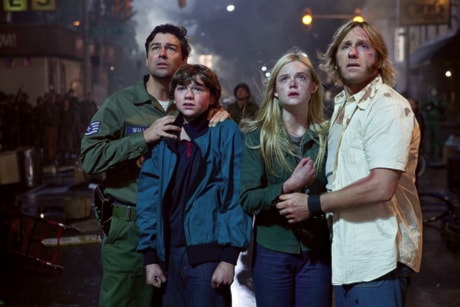Super 8 2 1/2 stars (out of 4) Rating: PG
Here’s how geeky J.J. Abrams gets with Super 8, his clever forgery of Spielbergian cinema.
In the sci-fi film’s fictional backwater of Lillian, Ohio, U.S. air force goons seek a missing and marauding whatsit, escapee from a suspicious train wreck. They call their search efforts “Operation Walking Distance.”
That’s a nod both to the code-name obsessions of Abrams’ TV mystery hit Lost and to the classic Twilight Zone episode Walking Distance, in which a jaded New Yorker magically returns to his childhood town.
The episode, Abrams’ professed favourite, includes an appearance by a very young Ron Howard, Steven Spielberg’s friend and frequent production partner.
Super 8, set in 1979, is shot full of this kind of pop-cult arcana, and it’s both wondrous and a bit vexing to behold. Is it possible to be sincere and fake at the same time?
Abrams conjures up a more than reasonable facsimile of the popcorn pics Spielberg churned out from the 1970s through early 1990s.
These are films like Close Encounters of the Third Kind, E.T. The Extra-Terrestrial and Jurassic Park, three of Super 8’s many shout-outs. (Other retro connections include The Goonies, Aliens, Gremlins and Abrams’ more recent Cloverfield.)
Writer/director Abrams has the blessing and mentorship of Spielberg, who gets a producer credit. Abrams has learned well from the master and made a movie that is never less than entertaining.
Yet Abrams fashions Super 8 in such a calculating manner, with every element weighed both for maximum nostalgia value and ironic hipster cred, that it has an artificial feel to it. It’s like a birthday cake made of spun glass.
Say what you will about Spielberg, but the man has never been anything but honest in his devotion to the aw-shucks pursuits of his mostly imagined Americana.
He’d happily milk a scene of dewy-eyed moppets confronting lonesome aliens or restless dinos, but the sentiment came naturally to him. There’s a reason why he was often compared to Frank Capra in his youth.
Not so Abrams, who is more of a magpie in his filmic influences. He collects them without necessarily caring about them, much like those infernal blue light flares he uses as an empty style exercise.
The title of Super 8 is itself a construct. It refers to an extinct film format that Spielberg used as a kid and Abrams claims also to have employed, but his age (44) suggests he was more of a video weenie. He’s a bit like Bryan Adams, age nine the summer of Woodstock, lamenting a lost love in Summer of ’69.
More to the point, Super 8 really isn’t about the Super 8 movie being shot by the gaggle of kids in the film’s episodic narrative, even though it does yield a quick glimpse of the missing whatsit — a revelation that isn’t essential.
The reference to the ancient film format is really meant to evoke a feeling of decades past, just like the fleeting glimpse we see of Walter Cronkite on TV, talking about the Three Mile Island nuclear mishap of 1979.
For all his attention to period detail, with ancient Dodges, rotary dial telephones and bustling U.S. steel factories (now there’s nostalgia), Abrams is surprisingly sloppy about the language of his pint-sized protagonists. They call each other “douche” and “dude,” something teens in the ’70s certainly weren’t doing, unless they were time travellers from the 21st century.
Abrams also relies too much on movie physics, notably in the train wreck that sets the whatsit loose amongst the good burghers of Lillian. The CGI-rendered crash, which strains credulity and theatre sound speakers, goes on for ages, yet exacts a miraculously low body count.
Bad things happen in Super 8, but they’re either off camera (like the factory-death prologue) or wholly unconvincing.
But if Abrams’ motives are suspect, his casting is impeccable, and on par with the best hires of Spielberg. Joel Courtney and Elle Fanning make cute as Joe and Alice, young huggers brought together by danger, MIA moms and dueling dads.
Riley Griffiths plays an amusing Charles, the junior DeMille (or Spielberg) wannabe who is making that Super 8 zombie movie that Super 8 really isn’t about.
Kyle Chandler evokes a younger and leaner Alec Baldwin in his role of the deputy sheriff who has to figure out what the whatsit is that’s terrifying Lillian’s townsfolk and mutts, and to do so while the Air Force goons are trying to shut him up.
And what exactly is that whatsit?
Well, to give some further credit to Abrams, he wisely keeps us guessing about whatever it is that escaped from that derailed train, which is scary enough to suggest that the Air Force has been up to some Very Bad Things that are about to be reckoned with.
Let’s just say that there’s no place like home, even when you have to phone for it. And also that Abrams believes in recycling as well as paying homage — you’ll think both Cloverfield and Transformers when the big reveal happens, which actually isn’t all that big.
But the best surprise of all comes during the credits, which are worth waiting for. Abrams shows us the complete zombie movie that Charles and the gang have been working on, and it’s funny — and also somehow far more sincere than Super 8.
Peter Howell is a syndicated Toronto Star movie critic.
